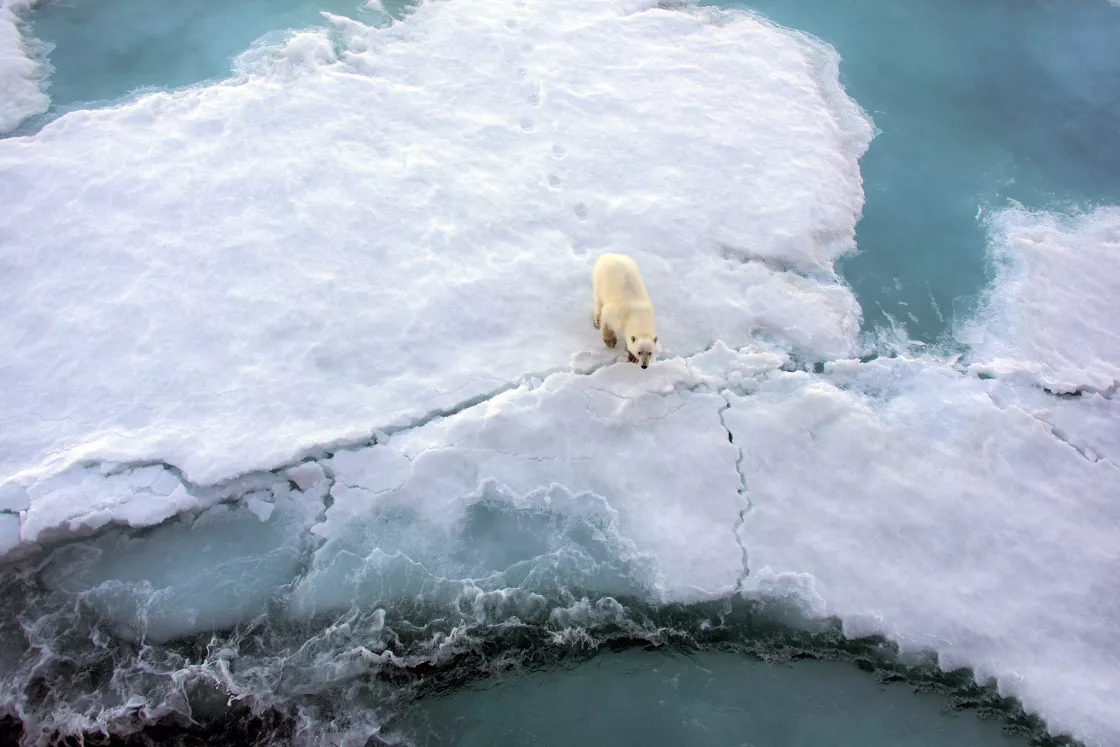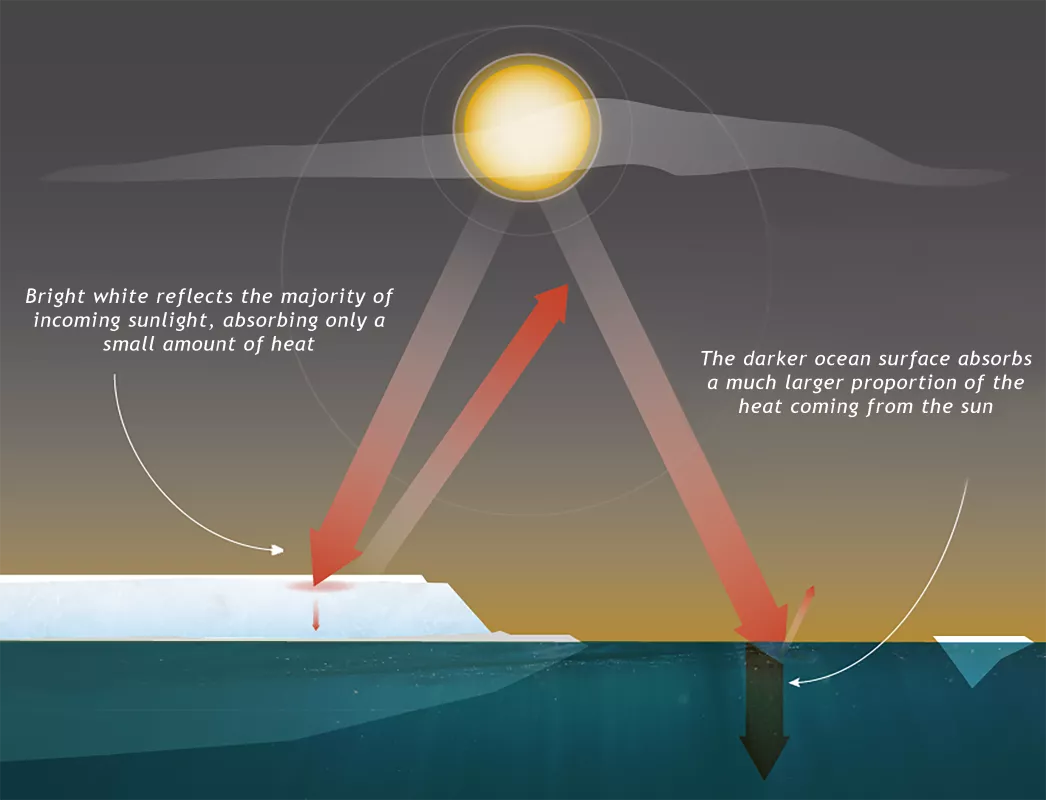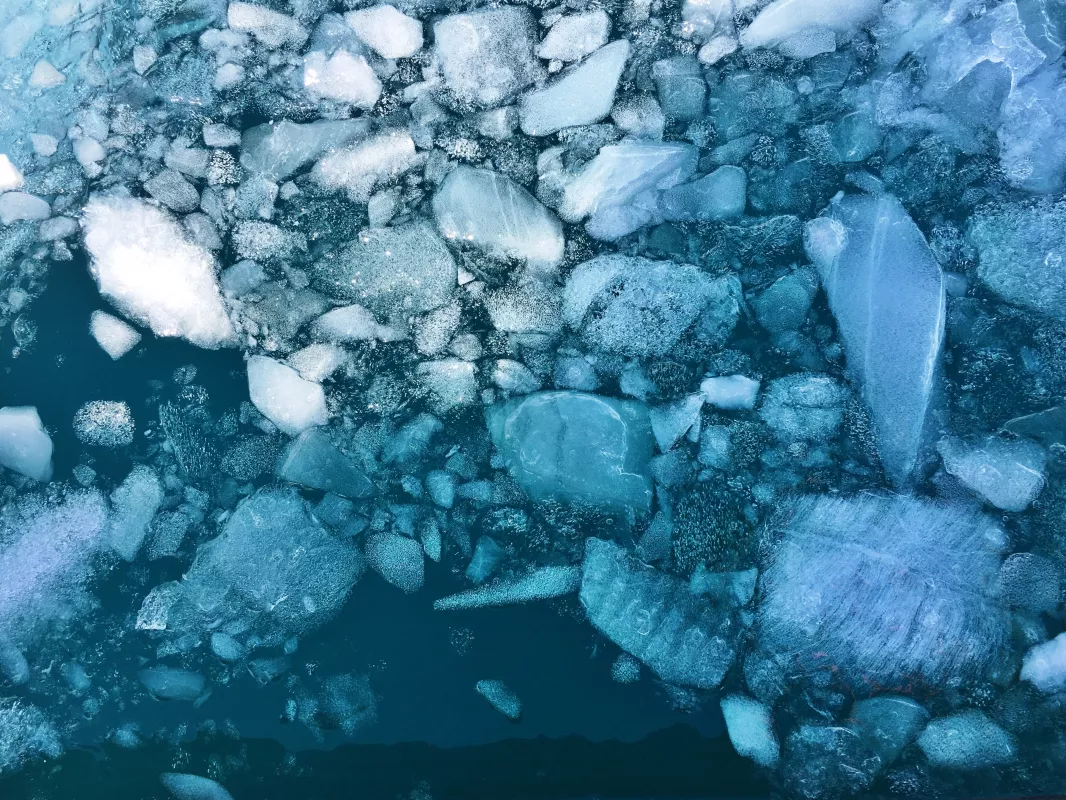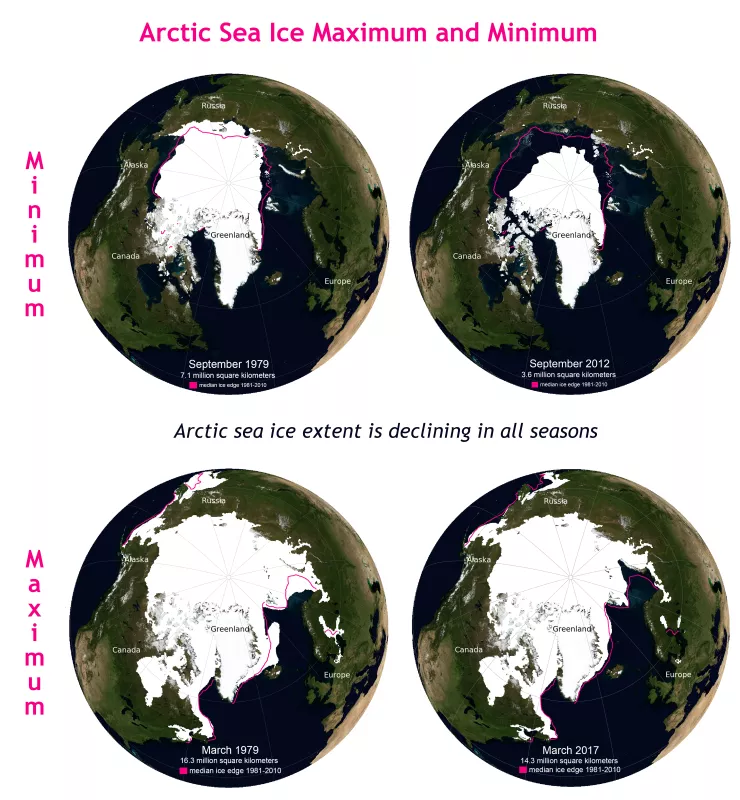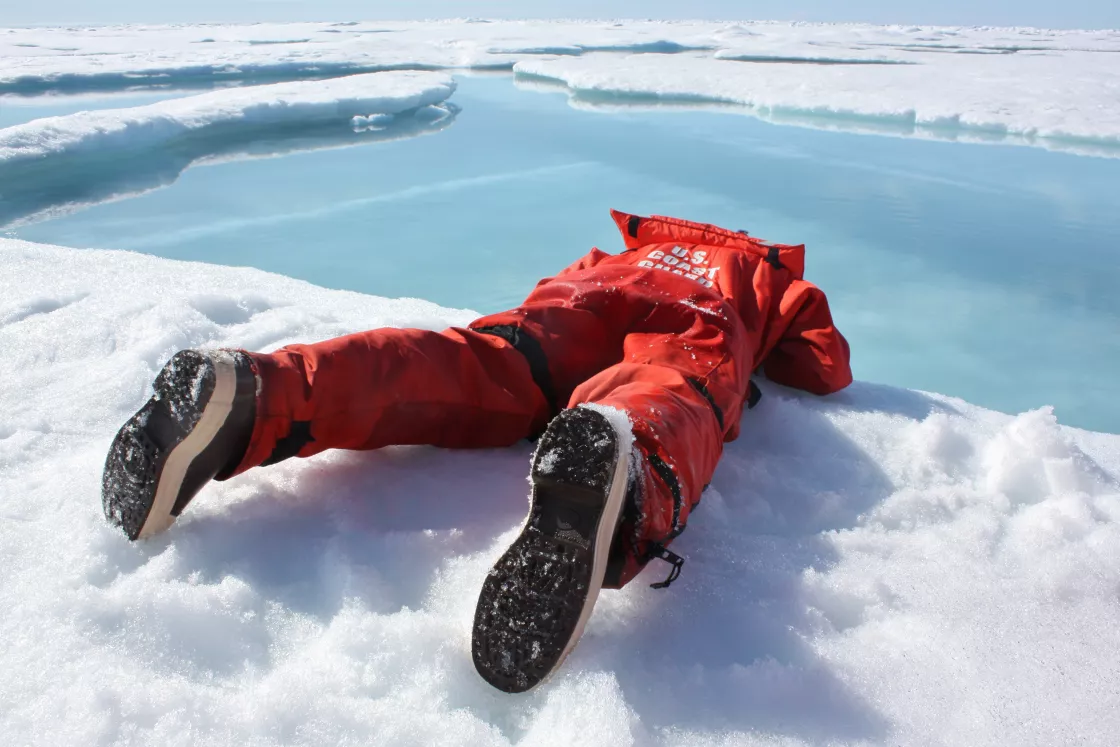Sea Ice
Quick Facts
What is sea ice?
Sea ice is frozen ocean water. It forms, grows, and melts entirely in the ocean. By contrast, icebergs, glaciers, and ice shelves float in the ocean but originate on land. For most of the year, sea ice is typically covered with snow.
Why is sea ice important?
Sea ice keeps the polar regions cool and helps moderate global climate. Sea ice has a much brighter surface compared to many other Earth surfaces, particularly the surrounding ocean. The darker ocean reflects only 6 percent of the sun’s energy and absorbs the rest, while sea ice reflects 50 to 70 percent of the incoming energy.
Snow has an even higher ability to reflect solar energy than sea ice. Snow-covered sea ice reflects as much as 90 percent of the incoming solar radiation. This serves to insulate the sea ice, maintaining cold temperatures and delaying ice melt in the summer.
As sea ice melts in the summer, it exposes the dark ocean surface. Instead of reflecting 80 percent of the sunlight, the ocean reflects only about 10 percent. So, oceans absorb about 90 percent of the sun’s energy, causing them to heat while surrounding temperatures rise further.
Thus, a small temperature increase at the poles leads to still greater warming over time, making the poles the most sensitive regions to climate change on Earth. According to scientific measurements, both the thickness and extent of summer sea ice in the Arctic have shown a dramatic decline since the 1980s. This is consistent with observations of a warming Arctic. The loss of sea ice also has the potential to accelerate global warming trends and to change climate patterns.
For more on the ways sea ice interacts with other Earth systems, including global ocean circulation, people, and animals, see Why sea ice matters.
Why is there greater focus on Arctic sea ice?
Scientists monitor both Arctic and Antarctic sea ice, but Arctic sea ice is more significant to understanding global climate because much more Arctic ice remains through the summer months, reflecting sunlight and cooling the planet.
Sea ice extent surrounding Antarctica fluctuates much more than the Arctic, in both space and time. Part of the difference is between their geographic layout: the Arctic is an ocean surrounded by land, while Antarctica is a continent surrounded by vast oceans. Sea ice can spread out more freely around Antarctica, and is often much thinner than Arctic sea ice. It also tends to nearly completely melt out during the summer months of the Southern Hemisphere.
Wind and ocean currents around Antarctica isolate the continent from global weather patterns, keeping it cold. By contrast, the Arctic Ocean is intimately linked with the climate systems around it, making it more sensitive to changes in climate.
Learn more about how Arctic and Antarctic sea ice differ.
What is sea ice extent?
Sea ice extent is a measurement of the ocean where there is at least some sea ice. Usually, scientists define a threshold of minimum concentration to mark the ice edge; the most common cutoff is at 15 percent. Scientists use the 15 percent cutoff because it generally provides the most consistent agreement between satellite and ground observations.
What is the difference between sea ice area and extent?
Area and extent are different measurements, providing slightly different information about sea ice conditions. Some organizations report ice area, but NSIDC primarily reports ice extent. Extent is always a larger number than area, and there are pros and cons associated with each method.
A simplified way to think of extent versus area is to imagine a slice of Swiss cheese. Extent would be a measure of the edges of the slice of cheese and all the space inside it. Area would be the measure of where there is cheese only, not including the holes. That is why, if you compare extent and area in the same time period, extent is always bigger. A more precise explanation of extent versus area gets more complicated.
Extent defines a region as “ice-covered” or “not ice-covered.” For each satellite data cell, the cell is said to either have ice or to have no ice, based on a threshold. The most common threshold (and the one NSIDC uses) is 15 percent, meaning that if the data cell has greater than 15 percent ice concentration, the cell is considered ice covered; less than that and it is said to be ice free. Example: Let’s say you have three 10 by 10 kilometer grid cells covered by 16 percent ice, 2 percent ice, and 90 percent ice. Two of the three cells would be considered “ice covered,” which means that the full grid cell area counts toward the extent. Sum up the grid cell of those two “ice-covered” grid cells, and you would get a total extent of 200 square kilometers, instead of the actual area of 108 square kilometers based on the concentration of each grid cell.
Area takes the percentages of sea ice within data cells and adds them up to report how much of the Arctic is covered by ice; area typically uses a threshold of 15 percent. So in the same example, with three 10 by 10 kilometer grid cells of 16 percent ice, 2 percent ice, and 90 percent ice, multiply the grid cell areas that are over the 15 percent threshold by the percent of sea ice in those grid cells, and add it up. You would have a total area of 106 square kilometers.
For more information, see NSIDC's Ask a Scientist post on this topic.
Why does NSIDC monitor sea ice extent, not area?
Scientists tend to focus on sea ice extent more closely than other aspects of sea ice because measurements of extent are more complete and accurate than other parameters, such as thickness or area.
Scientists at NSIDC report extent because summertime values of ice concentration and area taken from satellite sensors are less accurate. To the sensor, surface melt appears to be open water rather than water on top of sea ice. So, while reliable for measuring area most of the year, the microwave sensor is prone to underestimating the actual ice concentration and area when the surface is melting.
To account for that potential inaccuracy, NSIDC scientists rely primarily on extent when analyzing melt-season conditions and reporting them to the public. That said, analyzing ice area is still quite valuable. Given the right circumstances, background knowledge, and scientific information on current conditions, it can provide an excellent sense of how much ice there really is “on the ground.”
What is the sea ice minimum?
The sea ice minimum marks the day, each year, when the sea ice extent is at its lowest. The Arctic sea ice minimum occurs at the end of the summer melting season in the Northern Hemisphere, typically in September. The Antarctic sea ice minimum occurs at the end of the summer melting season in the Southern Hemisphere, typically in March. The Arctic summer melt season usually begins in March and ends sometime during September, while the Antarctic summer melt season is opposite—beginning in September and ending in March.
The Arctic sea ice minimum has been occurring later in recent years because of a longer melting season. However, ice growth and melt are local processes; sea ice in some areas will have already started growing before the date of the sea ice minimum, and ice in other areas will still shrink even after the date of the minimum.
Changes in the timing of the sea ice minimum extent are especially important because more of the sun's energy reaches Earth's surface during the Arctic summer than during the Arctic winter. As explained above, sea ice reflects much of the sun's radiation back into space, whereas dark, ice-free ocean water absorbs more of the sun's energy. So, reduced sea ice during the sunnier summer months has a big impact on the Arctic's overall energy balance.
For more information on current sea ice conditions, see the Sea Ice Today.
What is the sea ice maximum?
The sea ice maximum marks the day of the year when sea ice reaches its largest extent. The sea ice maximum occurs at the end of the winter cold season. This typically occurs in March for the Arctic and September for the Antarctic.
Monitoring winter sea ice is important to understand the state of the sea ice. Scientists have found that Arctic sea ice has been recovering less in the winter, meaning the sea ice is already thinner and smaller in extent when the summer melting season arrives. A possible cause is that the underlying ocean is warmer.
For more information on current sea ice conditions, see the Sea Ice Today.
Can you drink melted sea ice?
New ice is usually very salty because it contains concentrated droplets called brine that are trapped in pockets between the ice crystals, and so it would not make good drinking water. As ice ages, the brine eventually drains through the ice, and by the time it becomes multiyear ice, nearly all the brine is gone. Most multiyear ice is fresh enough that someone could drink its melted water. In fact, multiyear ice often supplies the fresh water needed for polar expeditions.
How do scientists monitor sea ice?
Obtaining reliable measurements of sea ice as it changes was difficult until the satellite era began in the early 1970s. To monitor Arctic sea ice extent, NSIDC primarily has used data from the NASA Scanning Multichannel Microwave Radiometer (SMMR) satellite and a series of Special Sensor Microwave/Imager (SSM/I) and Special Sensor Microwave Imager and Sounder (SSMIS) instruments on the US Defense Meteorological Satellite Program (DMSP) satellites. The satellites pass over the polar region several times each day to gather data. Researchers can then form the data into images for analysis and publication.
This series of satellites began monitoring sea ice in late 1978, and they continue to provide consistent data to regularly update sea ice conditions. More recently, NSIDC began archiving data from the Advanced Microwave Scanning Radiometer for the NASA Earth Observing System (AMSR-E) on the NASA Aqua satellite and the AMSR2 sensor on the Japanese Aerospace Exploration Agency (JAXA) Global Change Observation Mission-Water (GCOM-W) satellite. While the AMSR sensors provide greater spatial detail, NSIDC still primarily relies on SMMR-SSMI-SSMIS record because it provides a consistent, long-term record.
When scientists compare average sea ice conditions between years, they often use a 30-year reference period of 1981 to 2010. This reference period allows a consistent comparison of changes in extent over individual years.
To explore the satellite-derived sea ice images, see the Sea Ice Index.
